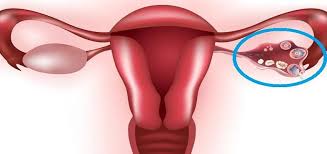Ovarian Cysts
Ovarian cysts are sacs within or on the surface of an ovary that are often filled with fluid. The ovaries are two in females. On either side of the uterus is one ovary.
Every ovary resembles an almond in both size and shape. Eggs grow and develop inside the ovaries. Monthly cycles of egg release occur during the childbearing years.
Cysts in the ovaries are prevalent. Most of the time, the cysts are innocuous and you experience little to no discomfort. Without medical intervention, most cysts disappear in a few months.
However, ovarian cysts can occasionally twist or rupture. Serious symptoms may result from this. Get routine pelvic exams and be aware of the symptoms that may indicate a significant issue to safeguard your health.

What Are Ovarian Excrescencies?
Ovarian excrescencies are fluid-filled sacs that form on or within an ovary. The ovaries are two almond-shaped organs located on either side of the uterus in ladies. They play a pivotal part in the reproductive system, including the product and release of eggs during the yearly menstrual cycle.
Characteristics of Ovarian Excrescencies
position Ovarian excrescencies can develop on the face of an ovary or inside it.
Size and Shape Excrescencies vary in size and shape, but they’re frequently round or round and filled with fluid.
Common Types of Ovarian Excrescencies
Functional Excrescencies
Follicular Excrescencies Form when the follicle, which should release an egg, doesn’t rupture or release the egg.
Corpus Luteum Excrescencies Develop after the follicle releases the egg and the follicle seals off but fills with fluid.
Pathological Excrescencies
Dermoid Excrescencies Contain colorful types of apkins, similar to hair, skin, or teeth.
Endometriomas Associated with endometriosis, these excrescencies form when endometrial towel grows on the ovaries.
Cystadenomas Arise from the cells on the face of the ovary and can be filled with a watery or mucous substance.
Symptoms and opinion
Common Symptoms
Asymptomatic-numerous ovarian excrescencies don’t beget conspicuous symptoms and may be discovered apropos during routine pelvic examinations.
Pain- Discomfort or pain in the lower tummy or pelvis, particularly if the tubercle is large or ruptures.
Bloating- lump or a feeling of wholeness in the abdominal area.
Menstrual Irregularities Changes in your menstrual cycle, including abnormal bleeding or missed ages.
opinion
Pelvic test– Your croaker may feel for excrescencies during a physical examination.
Ultrasound- An imaging test that uses sound swells to produce a picture of the ovaries, helping to assess the size, shape, and type of tubercle.
Blood Tests May be used to check hormone situations or for specific labels that can give fresh information about the tubercle.
operation and Treatment
Monitoring
Routine Pelvic Examinations–Regular check-ups can help cover the size and development of excrescencies.
Vigilant waiting- numerous excrescencies resolve on their own within many months without the need for medical intervention.
When to Seek Treatment
Wringing or Rupture- If a tubercle twists( torsion) or bursts, it can beget severe pain and bear immediate medical attention.
Patient Symptoms- If you witness ongoing discomfort, significant changes in menstrual cycles, or if the tubercle appears abnormal, further evaluation and treatment may be necessary.
Treatment Options
Specifics– Hormonal treatments similar to birth control capsules may be specified to help new excrescencies from forming.
Surgery- In cases where excrescencies are large, patient, or significant symptoms, surgical options may be considered to remove the tubercle.
Why Choose Gandhi Nursing Home?
At Gandhi Nursing Home, we provide expert care for ovarian cysts and other reproductive health concerns. Our services include:
- Experienced Specialists: Our healthcare providers are skilled in diagnosing and treating ovarian cysts, offering personalized care and treatment plans.
- Comprehensive Diagnostics: We use advanced imaging and diagnostic techniques to accurately assess and manage cysts.
- Patient-Centered Approach: We focus on understanding your specific needs and ensuring you receive the most effective and comfortable care.

